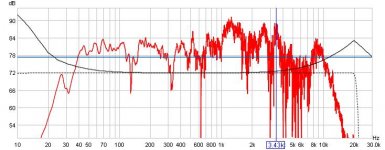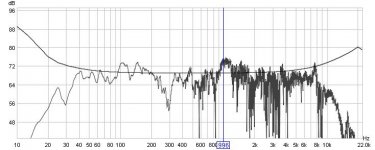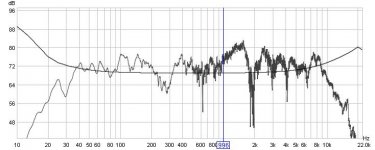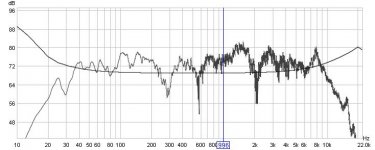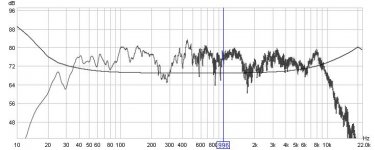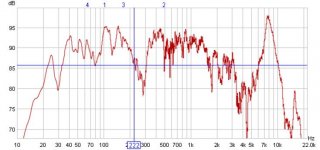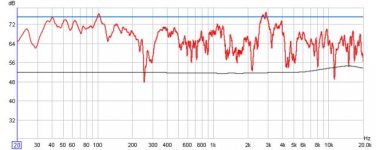Yes, I am listening to them at about 0.8m distant with a desk between me & the speaker, as well as a LCD monitor in between.
Here is the response by toeing in the speakers so that they cross in front of me. Looks a little better and better highs, allowing me to be less agressive for the highs with the EQ, giving clearer highs.
Regards,
Dean
Here is the response by toeing in the speakers so that they cross in front of me. Looks a little better and better highs, allowing me to be less agressive for the highs with the EQ, giving clearer highs.
Regards,
Dean
Attachments
The higher probably do suffer from reflections - the one time I've seena MLSSA measurement system in use the mic is quite close to the driver and the driver is kept well clear of surrounding hard objects.
The equalisation settings look quite interesting in the mid to LF, though. The setting adds a mild rise around 300Hz, which is about where I found the system balanced out using two drivers instead of one. As soon as I get another pair of drivers, I'll try a cabinet with two drivers per side and add a low pass filter to one of them around 300-500Hz.
The equalisation settings look quite interesting in the mid to LF, though. The setting adds a mild rise around 300Hz, which is about where I found the system balanced out using two drivers instead of one. As soon as I get another pair of drivers, I'll try a cabinet with two drivers per side and add a low pass filter to one of them around 300-500Hz.
More frequency measurements
As the room EQ software has been so easy to use to quickly produce full frequency sweep graphs after tuning, I thought I'd try a few things and measure.
Here is the frequency response by reversing the polarity of the subwoofer. This gets rid of the hole around the crossover region.
Regards,
Dean
As the room EQ software has been so easy to use to quickly produce full frequency sweep graphs after tuning, I thought I'd try a few things and measure.
Here is the frequency response by reversing the polarity of the subwoofer. This gets rid of the hole around the crossover region.
Regards,
Dean
Attachments
Here is placing towels between the speaker and the seat (on the desk). Similar improvement in the combing, proving that the ratty higher frequency response is due to the direct reflections and refraction from the immediate surroundings.
Regards,
Dean
Regards,
Dean
Attachments
Best of all
Placing a towel around the drivers to prevent any side propogation. This is a much cleaner response and probably what should be expected from this setup.
Looks like I'll have to arrange felt surrounds or similar for long term use for the Jordan's in this setup. So how does it sound now? Best way to describe it is cleaner & lower distortion, the soundstage is less than previous (perhaps because of the lack of reflections) but the instrument placement is much more distinct (as I reported when I tried the towel surrounding drivers trick with the tangbands).
The software I'm using is simple to use and very powerful, it should be a must for anyone making speakers. I was flying a bit blind without running these tests and it only takes 20 seconds to run a test to get these results! Highly recommended.
http://homepage.ntlworld.com/john.mulcahy/roomeq/index.html
Regards,
Dean
Placing a towel around the drivers to prevent any side propogation. This is a much cleaner response and probably what should be expected from this setup.
Looks like I'll have to arrange felt surrounds or similar for long term use for the Jordan's in this setup. So how does it sound now? Best way to describe it is cleaner & lower distortion, the soundstage is less than previous (perhaps because of the lack of reflections) but the instrument placement is much more distinct (as I reported when I tried the towel surrounding drivers trick with the tangbands).
The software I'm using is simple to use and very powerful, it should be a must for anyone making speakers. I was flying a bit blind without running these tests and it only takes 20 seconds to run a test to get these results! Highly recommended.
http://homepage.ntlworld.com/john.mulcahy/roomeq/index.html
Regards,
Dean
Attachments
Excellent stuff on the different responses with and without towels, giving a good measured insight to the effect of reflections. The software looks very impressive and, glory be, at first glance it looks like it might run on a Mac. Thanks for that link.
I noticed the effect on soundstaging some years ago when I had a desk on a line midway between two horn speakers. Once it was in place, the imagery collapsed back into the speakers. Covered in rugs, the soundstage was restored. The desk wasn't anywhere near being in the line of sight between me and the speakers. I now get very fussy about the environment around the speakers. (It's a good excuse for more books.)
I noticed the effect on soundstaging some years ago when I had a desk on a line midway between two horn speakers. Once it was in place, the imagery collapsed back into the speakers. Covered in rugs, the soundstage was restored. The desk wasn't anywhere near being in the line of sight between me and the speakers. I now get very fussy about the environment around the speakers. (It's a good excuse for more books.)
Jesper,
RE: high frequency rolloff, I think you are correct, as the speakers sound too bright if I try to compensate. The meter is a RS sound level meter set at C weighting and the measurement software takes into account the C weighting.
Here are more results with c weighting compensation turned off. A couple of ugly spikes at the high end now occur (and the measurement environment is the same as previously).
Regards,
Dean
RE: high frequency rolloff, I think you are correct, as the speakers sound too bright if I try to compensate. The meter is a RS sound level meter set at C weighting and the measurement software takes into account the C weighting.
Here are more results with c weighting compensation turned off. A couple of ugly spikes at the high end now occur (and the measurement environment is the same as previously).
Regards,
Dean
Attachments
Colin: I know that you have experiences for both JX92S and JXR6 drivers. I have JX92S in modified GM MLTL (30cm wide) and I am happy, but new JXR6 is available and I would like to try it together with Peerless 8" HDS PPB or Scan Speak 18W4531G00. Sensitivity for both of the drivers are 90dB.
How the midrange of JXR6 compares to JX92S? Vocals, piano... imaging ability? I am planning to use passive crossover around 200Hz. One option is that I won't put any passive components for Jordan.
How the midrange of JXR6 compares to JX92S? Vocals, piano... imaging ability? I am planning to use passive crossover around 200Hz. One option is that I won't put any passive components for Jordan.
Hi
The JX92 and JXR6 have a similar ability to pull out small details but they do sound a little different. The 6 is smoother, more delicate and more electrostatic-sounding, whereas the 92 comes across as slightly brasher, more exciting a listen. The 6 is very seductive, though, and definitely goes higher into the HF. The freedom from any sizzle or glare is really, really nice. I'm still using a pair on their own in the ceramic enclosures. Backed into corners or against walls the bass is surprisingly good, despite having no real weight to it.
Re imaging, in my current set up, the 92s win, with more depth. BUT, I haven't sorted edge reflections from the 6's cabinet yet and it is in a narrower cabinet to begin with, which might effect things.
The 6 with a Scanspeak or similar will, I suspect, be a more accurate speaker. Let us know how you get on.
The JX92 and JXR6 have a similar ability to pull out small details but they do sound a little different. The 6 is smoother, more delicate and more electrostatic-sounding, whereas the 92 comes across as slightly brasher, more exciting a listen. The 6 is very seductive, though, and definitely goes higher into the HF. The freedom from any sizzle or glare is really, really nice. I'm still using a pair on their own in the ceramic enclosures. Backed into corners or against walls the bass is surprisingly good, despite having no real weight to it.
Re imaging, in my current set up, the 92s win, with more depth. BUT, I haven't sorted edge reflections from the 6's cabinet yet and it is in a narrower cabinet to begin with, which might effect things.
The 6 with a Scanspeak or similar will, I suspect, be a more accurate speaker. Let us know how you get on.
Thank you Colin for a good answer. I trust your opinion and I will walk to the retailer and buy a pair of JXR6 speakers 
I am still unsure which driver I should use for lower frequencies. SS 18W4531G00 is a strong candidate. 90 dB efficiency, small cabinet and SS sliced paper cones have a very good reputation. It is quite expensive, but maybe good value for the money. Peerless costs less than half of the SS price...
I am still unsure which driver I should use for lower frequencies. SS 18W4531G00 is a strong candidate. 90 dB efficiency, small cabinet and SS sliced paper cones have a very good reputation. It is quite expensive, but maybe good value for the money. Peerless costs less than half of the SS price...
Go for the driver which suits the bass extension and cabinet size you want - the JXR6 is covering the important range. I'll be interested to hear what you come up with.
One thing to watch is that the JXR6 is a 4 ohm driver, so you have to be careful matching the bass output. Although on paper the JX92 would seem a good match, I've found the JXR6 is actually more sensitive and needs a bit of fiddling to bring it down to the 92's level. Going active would sort it but I thought fullrange was supposed to simplify things.
I had a go at matching the JXR6 to a redundant Scanspeak TL I had sitting around. Not a bad match for speed etc but I didn't get the levels right. The TL only went to 50Hz and rolled in at just over 100Hz so half the time I couldn't even tell it was there.
The Jordan cones are very light and sensitive to back reflections, so a non-reflective shape cabinet would be a good idea. And they don't come with any form of protection, so as soon as you get them, make a cardboard or plastic mask you can tape over the chassis whilst you're fitting them to the cabinets. One screw falling on the cone will dent it.
Good luck with the JXR6 project and I look forward to seeing how it turns out.
One thing to watch is that the JXR6 is a 4 ohm driver, so you have to be careful matching the bass output. Although on paper the JX92 would seem a good match, I've found the JXR6 is actually more sensitive and needs a bit of fiddling to bring it down to the 92's level. Going active would sort it but I thought fullrange was supposed to simplify things.
I had a go at matching the JXR6 to a redundant Scanspeak TL I had sitting around. Not a bad match for speed etc but I didn't get the levels right. The TL only went to 50Hz and rolled in at just over 100Hz so half the time I couldn't even tell it was there.
The Jordan cones are very light and sensitive to back reflections, so a non-reflective shape cabinet would be a good idea. And they don't come with any form of protection, so as soon as you get them, make a cardboard or plastic mask you can tape over the chassis whilst you're fitting them to the cabinets. One screw falling on the cone will dent it.
Good luck with the JXR6 project and I look forward to seeing how it turns out.
Updated frequency response charts
Finally I have set myself up with a decent measurement microphone, the RadioShack SPL meter is no good for speaker frequency response measurements.
I purchased the "mad about sound" mic & preamp kit which uses the panasonic WM61 electret, brass rod and a decent preamp. After loading up the MW61 generic calibration file into Room EQ wizard, I get a much flatter graph than those posted earlier in this thread. The graph has the subwoofer wired with inverse polarity (the 100 - 500Hz frequency range is flatter that way) as well as the speakers toed in about 20 degrees which provides a flatter treble response. If you have noticed that 100Hz and below looks boosted - its because I like it sounding that way!
To perfect this setup I will add electronic equalisation for the dip at 300Hz and the peak at 2Khz, as well as room impulse response correction and this project should be done. Fiddling around with the equaliser based on the results from Room EQ wizard using a digital convolver removes some of the mid range forwardness and does make it sound more neutral.
Regarding the back reflections, I used a couple of blocks of wood angled at 45 degrees to break up the back wave as well as stuffing to remove the reflections. I suspect its still not perfect as its possible the 2Khz peak is a function of the box and that the stuffing may be robbing the driver of some dynamics.
Regards,
Dean
Finally I have set myself up with a decent measurement microphone, the RadioShack SPL meter is no good for speaker frequency response measurements.
I purchased the "mad about sound" mic & preamp kit which uses the panasonic WM61 electret, brass rod and a decent preamp. After loading up the MW61 generic calibration file into Room EQ wizard, I get a much flatter graph than those posted earlier in this thread. The graph has the subwoofer wired with inverse polarity (the 100 - 500Hz frequency range is flatter that way) as well as the speakers toed in about 20 degrees which provides a flatter treble response. If you have noticed that 100Hz and below looks boosted - its because I like it sounding that way!
To perfect this setup I will add electronic equalisation for the dip at 300Hz and the peak at 2Khz, as well as room impulse response correction and this project should be done. Fiddling around with the equaliser based on the results from Room EQ wizard using a digital convolver removes some of the mid range forwardness and does make it sound more neutral.
Regarding the back reflections, I used a couple of blocks of wood angled at 45 degrees to break up the back wave as well as stuffing to remove the reflections. I suspect its still not perfect as its possible the 2Khz peak is a function of the box and that the stuffing may be robbing the driver of some dynamics.
Regards,
Dean
Attachments
Colin said:I believe the JXR6 is about to go into its second production run and there are one or two modifications being made prior to ramping up to a larger run.
Very interesting! What is being improved if this quality driver?
- Status
- This old topic is closed. If you want to reopen this topic, contact a moderator using the "Report Post" button.
- Home
- Loudspeakers
- Full Range
- JXR6 design analysis for near field setup
